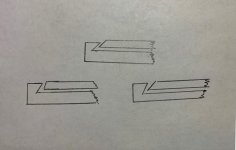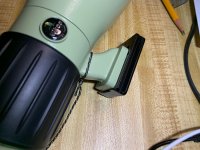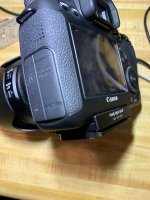PlayFreeBird
Active member
Recently I added a Pentax PF-80 to my panoply, with a The Birder tripod and a Manfrotto 502 clone head. Up to now I had an old Slik travel tripod, very light and equally flexible, but suitable for my mirrorless camera and Nikon ED50. I'm very impressed with the RC5 plate for the quick release on the clone head. The Pentax has both 1/4 and 3/8 inch threaded socket, so I can use both screws on the plate as well as the alignment pin and get a very solid connection. Then I got to thinking about using the heavy duty tripod with the 50 or the camera. But I don't want to put the honking 4 inch plate on either. And I certainly will never mount the Pentax on the Slik.
So I started looking at QR systems on the web and Amazon and trying to educate myself. I thought I would pass on what I've found in my rigorous two days of study. Please feel free to correct, expand, or commentate on any of this.
QR systems
There are 3 systems of note, the Arca-Swiss style, and Manfrotto systems RC2 and RC5. The Arca-Swiss style, named after the company that introduced it, is a plate with opposite edges beveled at 45 degrees. This allows it to be clamped to a flat base with jaws of a corresponding angle. The clamp is tightened either with a screw or a cam lever. If the entire jaw is mobile, then the plate can be dropped in from above before tightening. If part of it is fixed, the plate slides into the jaws from the edge. Pretty much everyone offers a version of this style. While many try to emulate the 38mm width, others do not. And because width, depth, height, and grooves and protrusions differ from maker to maker, it is a style rather than a standard.
For every different base and plate pair that works together, there is a pair that is incompatible.
The Manfrotto systems are, essentially Arca-Swiss style as well, although sufficiently distinct (in particular, they do not use a 45 degree angle) that they are not usually lumped together. Nor are they particularly superior to anyone else's version of a quick release. However, Manfrotto is sufficiently prominent that their abundant system is the choice of cloning third party makers. The RC2 is a smaller (about 2 inches square) plate, typically secured with a cam lever. The RC5 is about twice as long, with a hollow grooved bottom that will latch onto a safety catch pin projecting from the base. The pin prevents the plate from sliding off before the clamp is tightened. The plate is also slotted for the attachment screw access, allowing the instrument to be secured where needed for balance or access.
Like most people, I'd like to be able to mount any device on any stand. However as mentioned, the RC5 plate is fine for video cameras, big scopes, or other large equipment, but hardly appropriate for smaller devices. Therefore I searched for a short plate that would fit a RC5 base. As far as I can tell, no such choice exists. The next idea was to find a RC5 converter. And I did find one, by Pro Media which will fit an RC5 base and offers a Arca-Swiss clamp on top. The downside is that a single plate costs $40. Which makes DIY attractive. Buy a cloned RC5 for about $12 and screw on your choice of clamp and you have a converter (with a plate) for a little more than half the cost.
Now what to put on top is still obscure. For me, I could replace the Slik ball head with screw, with a ball head with QR. But the Slik version is quite minimal (in keeping with a minimal tripod, to be sure) and not necessarily the best general (or economical) choice. So I will probably find a base to screw on (tightly!) to the Slik and match it on a spare RC5 plate as a converter. Assuming I avoid analysis paralysis,:eek!:
So I started looking at QR systems on the web and Amazon and trying to educate myself. I thought I would pass on what I've found in my rigorous two days of study. Please feel free to correct, expand, or commentate on any of this.
QR systems
There are 3 systems of note, the Arca-Swiss style, and Manfrotto systems RC2 and RC5. The Arca-Swiss style, named after the company that introduced it, is a plate with opposite edges beveled at 45 degrees. This allows it to be clamped to a flat base with jaws of a corresponding angle. The clamp is tightened either with a screw or a cam lever. If the entire jaw is mobile, then the plate can be dropped in from above before tightening. If part of it is fixed, the plate slides into the jaws from the edge. Pretty much everyone offers a version of this style. While many try to emulate the 38mm width, others do not. And because width, depth, height, and grooves and protrusions differ from maker to maker, it is a style rather than a standard.
For every different base and plate pair that works together, there is a pair that is incompatible.
The Manfrotto systems are, essentially Arca-Swiss style as well, although sufficiently distinct (in particular, they do not use a 45 degree angle) that they are not usually lumped together. Nor are they particularly superior to anyone else's version of a quick release. However, Manfrotto is sufficiently prominent that their abundant system is the choice of cloning third party makers. The RC2 is a smaller (about 2 inches square) plate, typically secured with a cam lever. The RC5 is about twice as long, with a hollow grooved bottom that will latch onto a safety catch pin projecting from the base. The pin prevents the plate from sliding off before the clamp is tightened. The plate is also slotted for the attachment screw access, allowing the instrument to be secured where needed for balance or access.
Like most people, I'd like to be able to mount any device on any stand. However as mentioned, the RC5 plate is fine for video cameras, big scopes, or other large equipment, but hardly appropriate for smaller devices. Therefore I searched for a short plate that would fit a RC5 base. As far as I can tell, no such choice exists. The next idea was to find a RC5 converter. And I did find one, by Pro Media which will fit an RC5 base and offers a Arca-Swiss clamp on top. The downside is that a single plate costs $40. Which makes DIY attractive. Buy a cloned RC5 for about $12 and screw on your choice of clamp and you have a converter (with a plate) for a little more than half the cost.
Now what to put on top is still obscure. For me, I could replace the Slik ball head with screw, with a ball head with QR. But the Slik version is quite minimal (in keeping with a minimal tripod, to be sure) and not necessarily the best general (or economical) choice. So I will probably find a base to screw on (tightly!) to the Slik and match it on a spare RC5 plate as a converter. Assuming I avoid analysis paralysis,:eek!:







